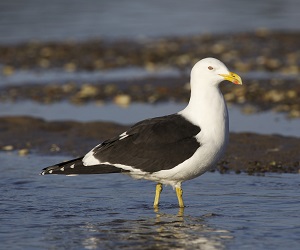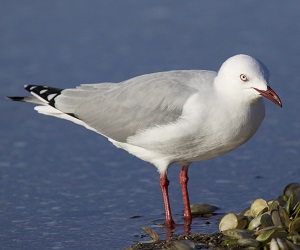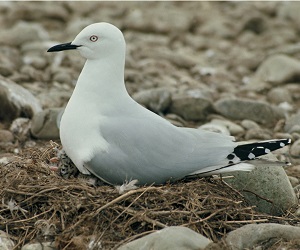Not Just Another Gull
Many people get the wrong end of the stick when it comes to seagulls. But there’s actually more to these chip-stealing birds, as Claudia Mischler writes.
“All gulls are the same!”
“Gulls are too noisy!”
“Those pesky gulls stole my fish and chips!”
Does this sound familiar? Many of us have a love-hate relationship with gulls. They remind us of summers spent at the beach with a packet of fish and chips.
But if you asked most people how many species of gull there are in New Zealand, most wouldn’t know the answer – let along the fact that one shares the status of “nationally critical” as the kiwi and kākāpō.
We actually have three species of gull. Meet New Zealand’s three different gulls and learn why they are all special in their own way.
Black-backed gull (Karoro)

Black-backed gulls are one of the most abundant and familiar birds in New Zealand. These large, grumpy looking birds are known for their intelligence and ability to hassle other birds out of a meal.
Because they adapt well to changes in land use, they are often found in large flocks near farms where they sometimes attack sheep or newborn lambs. They’re also a problem for our more endangered shorebirds, like black-billed gulls, dotterels, and shore plovers, as they are known to eat their eggs and chicks.
Red-billed gulls (Tarapunga)

Found in cities and towns around New Zealand, the red-billed gull looks very similar to the black-billed gull. You would think that the beak colour would give away which bird is which, but sometimes you will see a red-bill gull with a black-bill or a black-bill gull with a red bill. Confusing isn’t it?
Red-billed gulls nest in dense colonies on the coast. They can be quite loud and cheeky, but their numbers are in decline.
Over the next 30 years, their numbers are expected to fall by between 50 and 70 per cent and there are currently fewer than 100,000 left.
Black-billed gull (Tarapuka)

The black-billed gulls are actually quite shy and tend to mind their own business. They live inland, nesting on braided rivers – sometimes quite far from the coast. They feed at sea, but also like bugs from muddy paddocks or wet grassy areas.
Black-billed gulls are in trouble and now appear on threatened species lists, along with the kiwi and kākāpō.
Over the next 30 years, their numbers are expected to drop by more than 70 per cent. Just 40 years ago, there were nearly 200,000 of these birds, but now just 70,000 remain.
Like many of our native birds, introduced predators like cats, stoats and ferrets are a big problem for black-billed gulls. They’re known to take eggs, chicks and even adults. Weeds on their riverbed habitat is also a problem as it takes away space for them to breed and can force them closer to the water’s edge, which means their nests are more likely to get washed away.
The breeding season for the black-billed gull is coming up quickly, and we’re organising a full national census this year. Thanks to support from Birds NZ and Fruzio, we are able to fly over braided rivers in the South Island to photograph colonies and estimate how many birds are present.
What can you do?
Since I can only be in one place at a time, I need people like you on the ground. If you see a black-billed gull colony, please take note of where it is, what stage the birds are at (hanging out, nest building, incubating eggs, etc), and take lots of photographs. This will allow me to get a sense of timing.
Next time a little gull comes wandering past, try and challenge yourself to figure out which species it is. And if it’s a black-billed gull, consider yourself lucky to have spotted such a beautiful bird unique to New Zealand.
Spread the word about how special these gulls are, and help prevent their extinction!
